机电专业英语第2版13Unit 13.
- 格式:ppt
- 大小:4.23 MB
- 文档页数:43
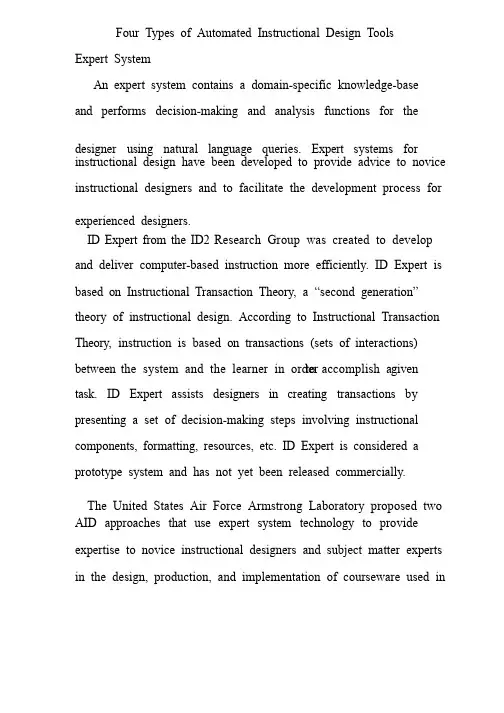
Four Types of Automated Instructional Design Tools Expert System An An expert expert expert system system system contains contains contains a a a domain-specific domain-specific domain-specific knowledge-base knowledge-base and performs decision-making and analysis functions for the designer using natural language queries. Expert systems for instructional design have been developed to provide advice to novice instructional designers and to facilitate the development process for experienced designers. ID ID Expert Expert Expert from from from the the the ID2 ID2 ID2 Research Group was created to develop Research Group was created to develop and deliver computer-based instruction more efficiently. ID Expert is based based on on on Instructional Instructional Instructional Transaction Transaction Transaction Theory, Theory, Theory, a a a ““second second generation generation generation””theory of instructional design. According to Instructional Transaction Theory, Theory, instruction instruction instruction is is is based based based on on on transactions transactions transactions (sets (sets (sets of of of interactions) interactions) between between the system and the learner in order the system and the learner in order to accomplish a g iven given task. ID Expert assists designers in creating transactions by presenting presenting a a a set set set of of of decision-making decision-making decision-making steps steps steps involving involving involving instructional instructional components, components, formatting, formatting, formatting, resources, resources, resources, etc. etc. etc. ID ID ID Expert Expert Expert is is is considered considered considered a a prototype system and has not yet been released commercially. The United States Air Force Armstrong Laboratory proposed two AID approaches that use expert system technology to provide expertise to novice instructional designers and subject matter experts in the design, production, and implementation of courseware used in Air Force training. Guided Approach to Instructional Design Advising Advising (GAIDA) (GAIDA) (GAIDA) uses uses uses tutorials tutorials tutorials and and and context-specific context-specific context-specific advice advice advice and and examples. Experiment Advanced Instructional Design Advisor (XAIDA) (XAIDA) uses uses uses the the the Instructional Instructional Instructional Transaction Transaction Transaction Theory Theory Theory framework framework framework to to encapsulate context-specific knowledge. Both of these environments are are results results results of of of the the the Advanced Advanced Advanced Instructional Instructional Instructional Design Design Design Adviser Adviser Adviser (AIDA) (AIDA) research project. Reactions to Expert Systems: While expert systems for the instructional instructional design design design can can can teach teach teach theory theory theory validation validation validation and and and function function function as as authoring tools, they are limited by their inability to support analysis and design tasks. ID expert systems attempt to control the instructional design process, a process involving a large number of interrelated elements, and so must rely heavily on the knowledge and experience of the individual practitioner. Several instructional technologists technologists have have have proposed proposed proposed systems systems systems that that that more more more subtly subtly subtly advise advise advise the the instructional designer, rather than prescribe a set of solutions. Advisory Systems Duchastel Duchastel challenges challenges challenges the the the expert expert expert system system system model model model by by by providing providing providing an an advisory advisory system system system model. model. model. Instead Instead Instead of of of controlling controlling controlling the the the problem-solving problem-solving process process with with with expert expert expert knowledge, knowledge, knowledge, advisory advisory advisory systems systems systems assist assist assist or or or coach coach users users in in in accomplishing accomplishing accomplishing a a a given given given task. task. task. A A A prototype prototype prototype for for for the the the advisory advisory system approach is the Instructional Design Advanced W orkbench, Workbench, architecture for a computer-based workbench that supports the cognitive cognitive tasks tasks tasks of of of instructional instructional instructional design design design without without without constraining constraining constraining the the designer. Information Management System Instructional Instructional Design Design Design Environment Environment Environment (IDE) (IDE) (IDE) from from from the the the Institute Institute Institute for for Research on Learning is a computer-aided design environment that supports supports an an an ID ID ID methodology methodology methodology for for for teaching teaching teaching the the the use use use of of of software software software in in real-life problem-solving contexts. I DE IDE IDE helps document design and helps document design and development development options. options. options. It It It is is is intented intented intented for for for experienced experienced experienced instructional instructional designers. Electronic Performance Support Systems Electronic performance support system (EPSS) are self-instructional self-instructional electronic electronic electronic environments environments environments that that that provide provide provide process process process to to “software, guidance, advice, data, tools, and assessment with minimum minimum support support support and and and intervention intervention intervention by by by others others others””. . EPPS EPPS EPPS have have have become become popular in the 1990s for business and education contexts that require “just-in-time just-in-time”” learning learning and and and a a a hign hign hign level level level of of of a a a particular particular particular skill. skill. skill. Some Some example of EPSS are listed below. Building on Duschastel’s “workbench,workbench,”” Paquette et al introduced a a performance performance performance support support support system system system called called called AGD AGD AGD (a (a (a French French French acronym acronym meaning Didactic Engineering W orkbench). AGD provides procedural procedural instructional instructional instructional design design design information information information to to to guide guide guide users users users difining difining the learning system (e.g., amount and nature of objectives). Other performance support systems tools include Designer’s Edge (Figure 13-1) from Allen Communication and Instructional DesignW are are from from from Langevin Langevin Langevin Learning Learning Learning Services Services Services (Langevin (Langevin (Langevin Learning Learning Services). Services). Like Like Like AGD, AGD, AGD, these these these tools tools tools support support support the the the planning planning planning phases phases phases of of instructional instructional design, design, design, but but but contain contain contain a a a much much much more more more general general general advisory advisory component (e.g., context-specific online help, wizard, and tutorials). In contrast to AGD, Designer Designer’’s Edge and Instructional DesignW are lead designers through all tasks involved in instructional design, but place more emphasis on the ultimate production phase. Both tools provide graphical representation of the instructional systems design model, thus leading to additional support for completing each step of the model. Data entered by users are are cross-referenced cross-referenced cross-referenced with with with all all all steps steps steps to to to enhance enhance enhance continuity continuity continuity between between phases. Usable reports and documents such as evaluation instruments, instruments, content content content outlines, outlines, outlines, lesson lesson lesson plans, plans, plans, and and and checklists checklists checklists can can can be be generated by the users. The The primary primary primary difference difference difference between between between the the the two two two products products products lies lies lies in in in their their intented audiences and purposes. Designer ’s Edge is for both novice and and experienced experienced experienced instructional instructional instructional designers designers designers planning planning planning computer-based computer-based instruction. The product includes support for scripts, storyboards and other other CBI CBI CBI production production needs. needs. Integration Integration Integration with with with external external external software software applications is also supported. Instructional Design W are is intented for for course course course designers designers designers and and trainers trainers interested interested interested in in producing producing either either computer-based or classroom training. For this reason ,more suppot is provided for decisions regarding media selection and course and presentation materials (Langevin Learning Services). 自动化教学设计工具的四种类型自动化教学设计工具的四种类型专家系统专家系统包括了一个特定领域的知识库和为设计师使用自然语言查询的执行决策分析功能。

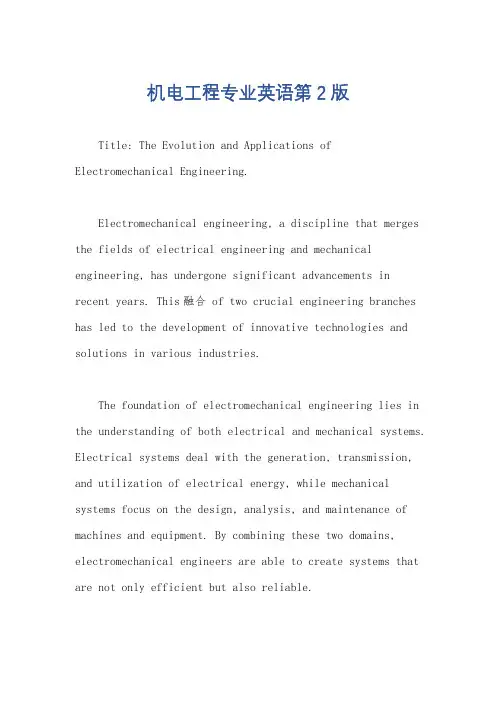
机电工程专业英语第2版Title: The Evolution and Applications of Electromechanical Engineering.Electromechanical engineering, a discipline that merges the fields of electrical engineering and mechanical engineering, has undergone significant advancements in recent years. This融合 of two crucial engineering branches has led to the development of innovative technologies and solutions in various industries.The foundation of electromechanical engineering lies in the understanding of both electrical and mechanical systems. Electrical systems deal with the generation, transmission, and utilization of electrical energy, while mechanical systems focus on the design, analysis, and maintenance of machines and equipment. By combining these two domains, electromechanical engineers are able to create systems that are not only efficient but also reliable.One of the most significant advancements in electromechanical engineering has been the integration of automation and robotics. With the increasing demand for precision and efficiency in manufacturing processes, the role of robots and automated systems has become paramount. Electromechanical engineers are responsible for designing and maintaining these systems, ensuring their seamless operation and optimal performance.Moreover, the integration of sensors and actuators has further enhanced the capabilities of electromechanical systems. Sensors are devices that detect and respond to external stimuli, while actuators convert energy into motion. By incorporating these devices into electromechanical systems, engineers can achieve precise control over various mechanical processes, leading to improved productivity and reduced waste.Another noteworthy advancement in electromechanical engineering is the increasing use of renewable energy sources. As the global focus shifts towards sustainable development, the integration of renewable energy systemsinto electromechanical designs has become crucial. Engineers are now exploring innovative ways to harness solar, wind, and other renewable energy sources, converting them into useful mechanical energy.In addition, the rising demand for smart and connected devices has also influenced the evolution of electromechanical engineering. The integration of sensors, actuators, and communication technologies into electromechanical systems has led to the development of smart devices that can communicate with each other and respond to external stimuli. This has opened up a wide range of applications in areas such as smart homes, smart cities, and工业自动化.Moreover, the increasing complexity of electromechanical systems has led to the development of advanced simulation and modeling tools. These tools allow engineers to simulate and analyze the behavior of electromechanical systems under different conditions, enabling them to predict and optimize their performance. This has significantly reduced the time and cost associatedwith the design and development of electromechanical systems.In conclusion, the evolution of electromechanical engineering has been driven by the increasing demand for efficiency, reliability, and sustainability. Theintegration of automation, robotics, sensors, actuators, renewable energy sources, and smart technologies has led to the development of innovative solutions in various industries. As technology continues to advance, the role of electromechanical engineers will become even more crucial in driving the development of efficient and sustainable systems.。
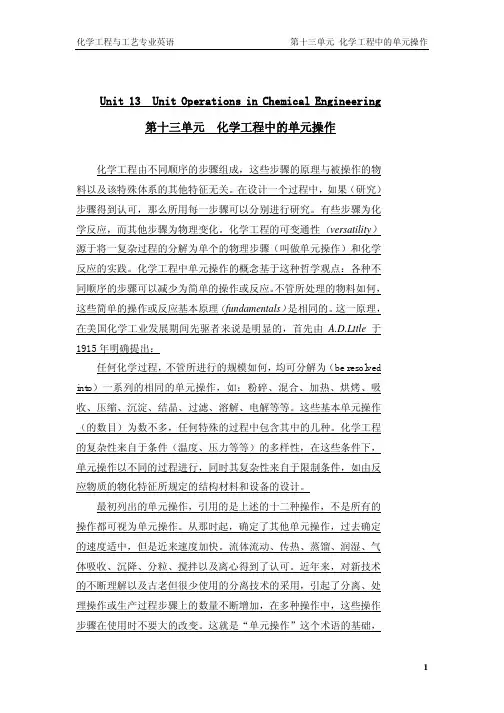
Unit13Unit Operations in Chemical Engineering 第十三单元化学工程中的单元操作化学工程由不同顺序的步骤组成,这些步骤的原理与被操作的物料以及该特殊体系的其他特征无关。
在设计一个过程中,如果(研究)步骤得到认可,那么所用每一步骤可以分别进行研究。
有些步骤为化学反应,而其他步骤为物理变化。
化学工程的可变通性(versatility)源于将一复杂过程的分解为单个的物理步骤(叫做单元操作)和化学反应的实践。
化学工程中单元操作的概念基于这种哲学观点:各种不同顺序的步骤可以减少为简单的操作或反应。
不管所处理的物料如何,这些简单的操作或反应基本原理(fundamentals)是相同的。
这一原理,在美国化学工业发展期间先驱者来说是明显的,首先由 A.D.Lttle于1915年明确提出:任何化学过程,不管所进行的规模如何,均可分解为(be resolved into)一系列的相同的单元操作,如:粉碎、混合、加热、烘烤、吸收、压缩、沉淀、结晶、过滤、溶解、电解等等。
这些基本单元操作(的数目)为数不多,任何特殊的过程中包含其中的几种。
化学工程的复杂性来自于条件(温度、压力等等)的多样性,在这些条件下,单元操作以不同的过程进行,同时其复杂性来自于限制条件,如由反应物质的物化特征所规定的结构材料和设备的设计。
最初列出的单元操作,引用的是上述的十二种操作,不是所有的操作都可视为单元操作。
从那时起,确定了其他单元操作,过去确定的速度适中,但是近来速度加快。
流体流动、传热、蒸馏、润湿、气体吸收、沉降、分粒、搅拌以及离心得到了认可。
近年来,对新技术的不断理解以及古老但很少使用的分离技术的采用,引起了分离、处理操作或生产过程步骤上的数量不断增加,在多种操作中,这些操作步骤在使用时不要大的改变。
这就是“单元操作”这个术语的基础,此基础为我们提供了一系列的技术。
1.单元操作的分类(1)流体流动流体流动所涉及到的是确定任何流体的从一位置到另一位置的流动或输送的原理。
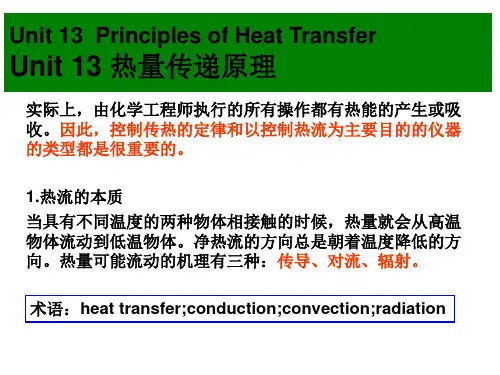
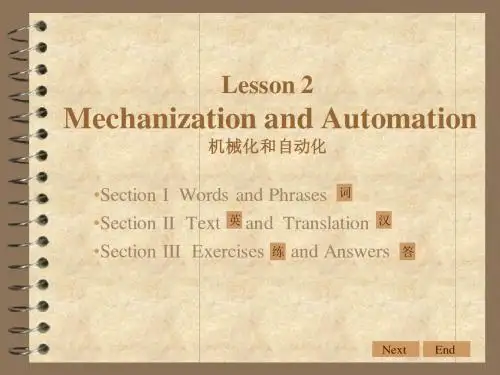
![[新版]机械工程专业英语教程(第2版)[施平主编][翻译]_lesson12](https://uimg.taocdn.com/62824efc18e8b8f67c1cfad6195f312b3169eb4d.webp)
Spur GearsGears , defined as toothed members transmitting rotary motion from one shaft to another , are among the oldest devices and inventions of man . In about 2600 B.C. , the Chinese are known to have used a chariot incorporating a complex series of gears . Aristotle , in the fourth century B.C. , wrote of gears as if they were commonplace . In the fifteenth century A.D. , Leonardo da Vinci designed a multitude of devices incorporating many kinds of gears .齿轮,在最古老的设备和发明人中,被定义为通过轮齿将旋转运动从一根轴传递到另一根轴,大约在公元前2600年,中国人就知道用战车组成一系列复杂的齿轮系。
西元前四世纪,亚里士多德记述了齿轮就好像是他们司空见惯的一样。
在十五世纪,达芬奇设计了大量的包含各种各样齿轮的设备。
Among the various means of mechanical power transmission (including primarily gears , belts , and chains ) , gears are generally the most rugged and durable . Their power transmission efficiency is as high as 98 percent . On the other hand , gears are usually more costly than chains and belts . As would be expected , gear manufacturing costs increase sharply with increased precision -- as required for the combination of high speeds and heavy loads , and for low noise levels . ( Standard tolerances for various degrees of manufacturing precision have been established by the AGMA , American Gear Manufacturers Association. )在众多的机械传动方式中(包括齿轮传动,带传动,链传动),一般来说,齿轮是最经久耐用的,它的能量传递效率高达98%。
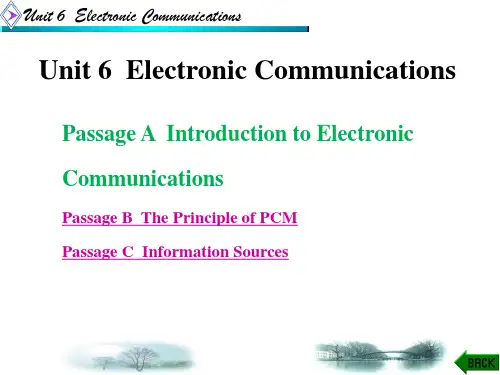
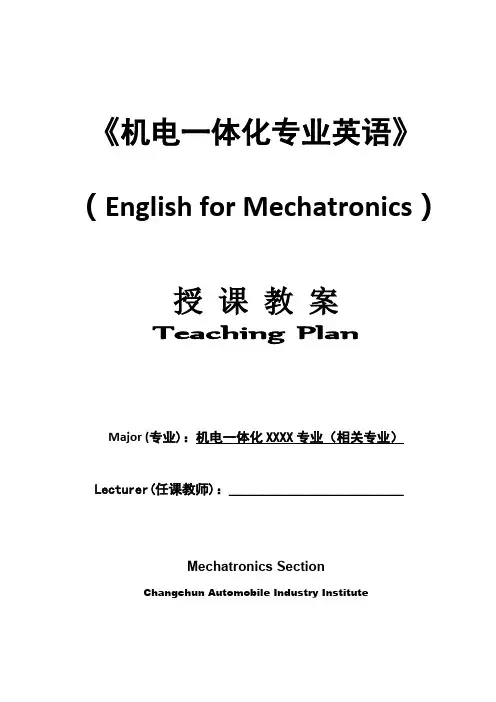
《机电一体化专业英语》(English for Mechatronics)授课教案Teaching PlanMajor (专业):机电一体化XXXX专业(相关专业)Lecturer(任课教师):__________________________Mechatronics SectionChangchun Automobile Industry Institute《机电一体化专业英语》授课计划_ _______ 学院___ 专业班20 -20 学年第学期授课时间:第周ensure that…又引导出一个状语从句。
全句可译为:在把花盘安装在主轴上后, 常规作法是对断面进行一次性地轻切削以确保花盘表面与车床主轴垂直。
Period1The following is the machine tool structures.Explanations of the Machine Tool TermsNo.NameExplanation1 Spindle speed selector 主轴速度转换开关2 Headstock assembly 主轴箱3 Spindle with chuck 附有夹具主轴 4Tool post 刀架 5 pound rest 复式刀架 6 Cross slide 横向拖板 7 Carriage 滑鞍,滑座 8 Ways 导轨 9 Dead center 死顶尖 10 Tailstock quill 尾架顶尖套筒 11 Tailstock assembly 尾架 12 Hand-wheel 手轮 13 Bed 底座,床身 14 Lead screw 丝杠 15 Feed rod 进刀杠,光杠 16 Clutch离合器17 Longitudinal & transverse feed control 纵向与横向进给控制 18 Split-nut control 开合螺母控制 19 Apron 溜板箱,进给箱 20 Chip pan 承屑盘 21Feed selector进给选择开关机床构造 Section II Glance at Machine Tool StructuresThe following is the conventional machine tool. You are required to choose the suitable words or phrases given below.7. Body G. 公英制转换键8. Calibration sticker H. 液晶显示屏9. Depth bar I. 外径测量面10. Zero-setting key J. 滑尺11. On/Off key K. 电池盖12. Slider L. 清零键13. Outside measuring face M. 测深杆Period 1Practice扩大您地视野(实践部分)Section IV BroadenYour Horizon—Practical Activity(Practice) The micrometer screw gaugeThe micrometer screw gauge is used to measure even smaller dimensions than the vernier caliper. The micrometer screw gauge also uses an auxiliary scale (measuring hundredths of a millimeter) which is marked on a rotary thimble. Basically it is a screw with an accurately constant pitch. The micrometers in our laboratory have a pitch of 0.50 mm. The rotating thimble is subdivided into 50 equal divisions. The thimble passes through a frame that carries a millimetre scale graduated to 0.5 mm. The jaws can be adjusted by rotating the thimble using the small ratchet knob. The thimble must be rotated through two revolutions to open the jaws by 1 mm. Here is a useful applet to learn how to use the micrometer screw gauge (Figure 1-19).Figure 1-19 The micrometer screw gaugeIn order to measure an object, the object is placed between the jaws and the thimble is rotated using the ratchet until the object is secured. Note that the ratchet knob must be used to secure the object firmly between the jaws, otherwise the instrument could be damaged or give an inconsistent reading.Note that an additional half scale division (0.5 mm) must be included if the mark below the main scale is visible between the thimble and the main scale division on the sleeve. The remaining two significant figures (hundredths of a millimeter) are taken directly from the thimble opposite the main scale.In Figure 1-20 the last graduation visible to the left of the thimble is 7 mm and the thimble lines up with the main scale at 38 hundredths of a millimeter (0.38 mm); therefore the reading is 7.38 mm.In Figure 1-21 the last graduation visible to the left of the thimble is 7.5 mm; therefore the reading is 7.5 mm plus the thimble reading of 0.22 mm, giving 7.72 mm.Figure 1-20 The reading is 7.38mm Figure 1-21 The reading is 7.27mm In Figure 1-22 the main scale reading is 3 mm while the reading on the drum is 0.46 mm; therefore, the reading is 3.46 mm.In Figure 1-23 the 0.5 mm division is visible below the main scale; therefore the reading is 3.5 mm + 0.06 mm = 3.56 mm.Figure 1-22 The reading is 3.46mm Figure 1-23 The reading is 3.56mm Try the following bg yourselfFigure 1-24 Figure 1-25 Figure 1-26A: Do exercise 1, 2, 3, 4 and 7.AssignmentB: Ask students to collect some external machine tools.《机电一体化专业英语》授课计划_ _______ 学院___ 专业班20 -20 学年第学期授课时间:第周Key Points unit.2. Machine tool practice cognition.教学难点Difficult Points 1. Understand the key words, phrases and sentences in the passage.2. Translate the simple material or specification.教学方法Teaching Methods • Explanation • Group discussion • Questions and answers • Performance (Role-play) • Machine tool specification教学手段TeachingMeans• Multi-media • Videos • work Resource教学安排Teaching Arrangement教学内容Contents of Course学时Period精读Section I Technical and Practical Reading2机床构造Section II Glance at the Structure of the Machine Tool1试试身手(实践部分)Section III Simulated Writing (Practice)2扩大您地视野(实践部分)Section IV Broaden Your Horizon—Practical Activity (Practice)1授课内容与要点Teaching Contents and Main PointsUnit 2 Metal MaterialsPeriod2精读Section I Technical and Practical Reading Part I. Leading in1. RevisionAsk several students if they know the machine tool structures, metal materials and important machine tool manufacturers.Arouse students to answer teacher’s questions according to the Passage A /B for introduction to meta materials in Unit 2.2. Warming up questions1) Ask students to work in groups of four to read new words and phrases.5. ________(工具铣床)6. ________ (单柱铣床)Single-column Milling Machine Plano-milling MachineTool Milling MachineKnee-and-Column Milling Instrument milling machine Single-arm Milling MachinePeriod2Have a TrySample 1Explanations of TermsNameExplanationOuter frame 外框 Scale mark plate刻度盘 Spring 弹簧 Arm测量臂 Gauge head 侧头 Dial window 刻度盘 Indicator 指针 Clamp screw夹紧螺丝Choose the best answer.试试身手 (实践部分) Section III Simulated Writing (Practice)AB1. Dial windowA. 限制器 2. Long handB. 短指针 3. Top pointC. 刻度盘 4. LimiterD. 刻度盘 5. ClumpE. 长指针 6. Outer frameF. 底座 7. Short handG. 顶针8. BaseH. 螺丝紧固座 9. Scale mark plate I. 紧固件 10. Screw fastening base J. 测头 11.Gauge headK. 外框Period1Practice扩大您地视野 (实践部分)Section IV BroadenFacing OperationsFacing is the process of removing metal from the end of a work-piece to produce a flat surface.Preparing for the Facing CutYour Horizon—Practical Activity (Practice) First, make sure the tumbler gear lever on the back of the headstock is in the neutral (middle) position so that the lead-screw does not rotate.Clamp the work-piece tightly in the three-jaw chuck. To get the work properly centered, close the jaws until they just touch the surface of the work, then rotate the work-piece by hand in the jaws to seat it; then tighten the jaws (Figure 2-17). Beginning the Facing CutUse the pound handwheel to advance the tip of the tool until it just touches the end of the work-piece. Use the cross feed crank to back off the tool until it is beyond the diameter of the work-piece. Turn the lathe on and adjust the speed to a few hundred RPM — setting of the speed control knob. Now slowly advance the cross feed hand-wheel to move the tool towards the work-piece. When the tool touches the work-piece it should start to remove metal from the end (Figure 2-18). Continue advancing the tool until it reaches the center of the work-piece and then crank the tool back in the opposite direction (towards you) until it is back past the edge of the work-piece (Figure 2-19).Figure 2-18 Figure 2-19 Since we started with the tool just touching the end of the work-piece, you probably removed very little metal on this pass. This is a good idea until you get used to how aggressively you can remove metal without stalling the lathe.The Roughing CutUse the pound crank to advance the tool towards the chuck about 0.010". If the pound is set at a 90 degrees to the cross slide (which is how I usually set mine) then each division you turn the crank will advance the tool 0.001 (one-thousandth of an inch) toward the chuck.If the pound is set at some other angle, say 30 degrees, to the cross slide, then it will advance the tool less than 0.001 for each division. The exact amount is determined by the trigonometric sine of the angle. Here’s a picture of the first pass of a facing operation (Figure 2-20).Cutting on the Return PassIf you crank the tool back towards you after it reaches the center of the work-piece you will notice that it removes a small amount of metal on the return pass. This is because the surface is not perfectly smooth and it is removing metal from the high spots. If you need to remove a lot of metal, to reduce the work-piece to a specific length, for example, you can take advantage of this return cut to remove more metal on each pass by advancing the tool a small ways into the work-piece on the return pass. Since the tool must plunge into the face of the work-piece, this works best with a fairly sharp pointed tool.The Finishing CutDepending on how rough the end of the work-piece was to begin with and how large the diameter is, you may need to make three or more passes to get a nice smooth finish across the face. These initial passes are called roughing passes and remove a relatively large amount of metal.When you get the face pretty smooth you can make a final finishing cut to remove just 0.001 to 0.003" of metal and get a nice smooth surface. Figure 2-21 shows removingabout 0.002" of metal at around 1 000 RPM. Figure 2-22 shows the finished face of thework-piece. Figure 2-21 Figure 2-22Figure 2-23 shows what happens if the tip of your cutting tool is below the center line of the lathe — a little nub is left at the center of the work-piece. The same thing happens ifthe tool is too high but the nub will have more of a cone shape in that case. If the tool is toolow, place a suitable thickness of shim stock underneath the tool in the tool holder. If it’s toohigh, grind the top down a few thous.Filing the EdgeFacing operations leave a rather sharp edge on the end of the work-piece. It’s a good idea to smooth this edge down with a file to give it a nice chamfer and to avoid cuttingyourself on it. With the lathe running at fairly low speed, bring a smooth cut file up to theend of the work-piece at a 45 degree angle and apply a little pressure to the file. Figure2-24: Right — left hand holding tang end of file. Figure 2-25: Wrong — left hand reachingover spinning chuck!Figure 2-23 Figure 2-24Figure 2-26 shows the finished surface and beveled edge. This is what a good facing cut should look like: smooth even surface with no raised bump in the center. Lay anaccurate straight edge across the surface of the face and you should not be able to seeany light under the edge. If you detect a slight convex shape, the carriage may be movingback away from the headstock during the cut.Figure 2-25 Figure 2-26A: Do exercise 1, 2, 3, 4 and 7.AssignmentB: Ask students to collect some external machine tools.《机电一体化专业英语》授课计划_ _______ 学院___ 专业班20 -20 学年第学期授课时间:第周教学难点Difficult Points 1. Understand the key words, phrases and sentences in the passage.2. Translate the simple material or specification.教学方法Teaching Methods • Explanation • Group discussion • Questions and answers • Performance (Role-play) • Machine tool specification教学手段TeachingMeans• Multi-media • Videos • work Resource教学安排Teaching Arrangement教学内容Contents of Course学时Period精读Section I Technical and Practical Reading2机床构造Section II Glance at the Machine Tool Structures1试试身手(实践部分)Section III Simulated Writing (Practice)2听说练习(实践部分)Section IV Broaden Your Horizon—Practical Activity (Practice)1授课内容与要点Teaching Contents and Main PointsUnit 3 Machining OperationsPeriod2精读Section I Technical and Practical Reading Part I. Leading in1. RevisionAsk several students if they know the basic machine tool and its function.Arouse students to answer teacher’s questions according to the Passage A /B for introduction to basic machine tools in Unit 3.2. Warming up questions1) Ask students to work in groups of four to read new words and phrases.2) Talk about the basic boring machines.Part II. prehension and PracticingSentences:1. Conventional machining, one of the most important material removal methods, is a collection of material-working processes in which power-driven machine tools, such as lathes, milling machines, and drill presses are used with a sharp cutting tool to mechanically cut the material to achieve the desired geometry. 在这个长句中,主语是Conventional machining,由is引导出合成谓语;one of the most…methods是插入语;in which 引导定语从句,其先行词为processes。
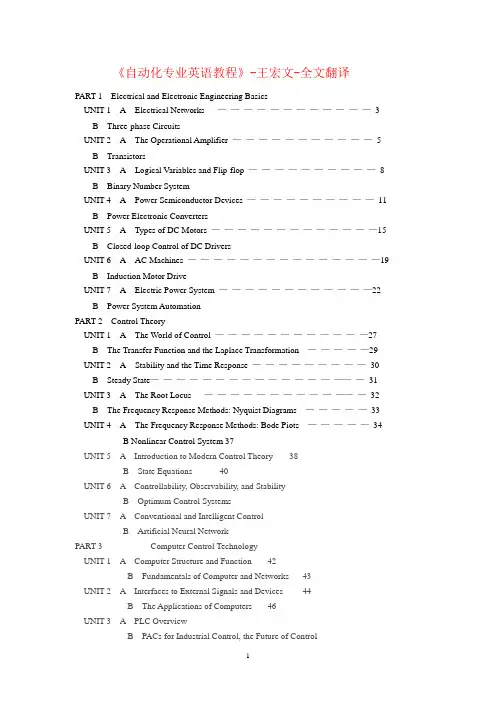
《自动化专业英语教程》-王宏文-全文翻译PART 1Electrical and Electronic Engineering BasicsUNIT 1A Electrical Networks ————————————3B Three-phase CircuitsUNIT 2A The Operational Amplifier ———————————5B TransistorsUNIT 3A Logical Variables and Flip-flop ——————————8B Binary Number SystemUNIT 4A Power Semiconductor Devices ——————————11B Power Electronic ConvertersUNIT 5A Types of DC Motors —————————————15B Closed-loop Control of DC DriversUNIT 6A AC Machines ———————————————19B Induction Motor DriveUNIT 7A Electric Power System ————————————22B Power System AutomationPART 2Control TheoryUNIT 1A The World of Control ————————————27B The Transfer Function and the Laplace Transformation —————29 UNIT 2A Stability and the Time Response —————————30B Steady State—————————————————31 UNIT 3A The Root Locus —————————————32B The Frequency Response Methods: Nyquist Diagrams —————33 UNIT 4A The Frequency Response Methods: Bode Piots —————34B Nonlinear Control System 37UNIT 5 A Introduction to Modern Control Theory 38B State Equations 40UNIT 6 A Controllability, Observability, and StabilityB Optimum Control SystemsUNIT 7 A Conventional and Intelligent ControlB Artificial Neural NetworkPART 3 Computer Control TechnologyUNIT 1 A Computer Structure and Function 42B Fundamentals of Computer and Networks 43UNIT 2 A Interfaces to External Signals and Devices 44B The Applications of Computers 46UNIT 3 A PLC OverviewB PACs for Industrial Control, the Future of ControlUNIT 4 A Fundamentals of Single-chip Microcomputer 49B Understanding DSP and Its UsesUNIT 5 A A First Look at Embedded SystemsB Embedded Systems DesignPART 4 Process ControlUNIT 1 A A Process Control System 50B Fundamentals of Process Control 52UNIT 2 A Sensors and Transmitters 53B Final Control Elements and ControllersUNIT 3 A P Controllers and PI ControllersB PID Controllers and Other ControllersUNIT 4 A Indicating InstrumentsB Control PanelsPART 5 Control Based on Network and InformationUNIT 1 A Automation Networking Application AreasB Evolution of Control System ArchitectureUNIT 2 A Fundamental Issues in Networked Control SystemsB Stability of NCSs with Network-induced DelayUNIT 3 A Fundamentals of the Database SystemB Virtual Manufacturing—A Growing Trend in AutomationUNIT 4 A Concepts of Computer Integrated ManufacturingB Enterprise Resources Planning and BeyondPART 6 Synthetic Applications of Automatic TechnologyUNIT 1 A Recent Advances and Future Trends in Electrical Machine DriversB System Evolution in Intelligent BuildingsUNIT 2 A Industrial RobotB A General Introduction to Pattern RecognitionUNIT 3 A Renewable EnergyB Electric VehiclesUNIT 1A 电路电路或电网络由以某种方式连接的电阻器、电感器和电容器等元件组成。
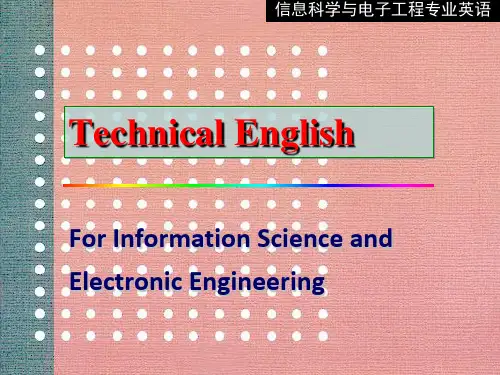
1.With low-power machinery or vehicles the operator can usually apply sufficient force through a simple mechanical linkage from the pedle or handle to the stationary part of the brake. In many cases, however, this force must be multiplied by using an elaborate braking system(P5.)用低能机器或传力工具,操作者通过向踏板或把手的一个简单机械连接构件作用足够的力量到车闸固定的部分。
大多数情况,然而,用一个详细(复杂)的车闸系统使这个力量成倍增加。
2.The fundamental principle involved is the use of compressed air acting through a piston in a cylinder to set block brakes on the wheels. The action is simultaneous on the wheels of all thecars in the train. The compressed air is carried through a strong hose from car to car withcouplings between cars; its release to all the separate block brake units, at the same time, is controlled by the engineer. (Braking Systems)( P5)相关的基本原理是使用压缩气体,通过气缸内的活塞将闸块压在车轮起作用。
Unite 1Section A: 1、artificial intelligence 人工智能2、paper-tape reader 纸带阅读器3、Optical computer 光学计算机4、Neural network 神经网络5、Instruction set 指令集6、Parallel processing 并行处理器7、Difference engine差分机8、Versatile logical element 多用途逻辑元件9、Silicon substrate 硅衬底10、Vaccum tube 真空管11、数据的存储与管理the storage and management of data12、超大规模集成电路large-scale integrated circuit13、中央处理器central processing unit14、个人计算机personal computer15、模拟计算机analog computer16、数字计算机digital computer17、通用计算机general purpose computer18、处理器芯片processor chip19、操作指令operating instructions20、输入设备input devicesSection B1、artificial neural network 人工智能神经网络2、Computer architecture 计算机体系结构3、Robust computer program 健壮的计算机程序4、Human-computer interface 人机接口5、Knowledge representation 知识代表6、数值分析numerical analysis7、程序设计环境programming environment8、数据结构data structure9、存储和检索信息store and retrieve information10、虚拟现实virtual realityUnit 2Section A:1、function key 功能键2、V oice recognition module 声音识别调制器3、Touch-sensitive region 触敏扫描仪4、Address bus 地址总线5、Flatbed scanner 平板扫描仪6、Dot-matrix printer 矩阵式打印机7、Parallel connection 并行连接8、Cathode ray tube 阴极射线管9、Video game 电子游戏10、Audio signal 音频信号11、操作系统operating system12、液晶显示liquid crystal display13、喷墨打印机inkjet printer14、数据总线data bus15、串行连接serial connection16、易失性存储器volatile memory17、激光打印机laser printer18、磁盘存储器floppy disc19、基本输入输出系统basic input/output system20、视频显示器video displaySection B:1、interrupt handler 中断处理程序2、Virtual memory 虚拟内存3、Context switch 上下文转换4、Main memory 主存5、Bit pattern 位模式6、外围设备peripheral device7、进程表process table8、时间片time slice9、图形用户界面graphics user interface10、海量存储器mass storageUnit 3Section A:1、storage register 存储寄存器2、Function statement 函数语句3、Program statement 程序语句4、Object-oriented language 面向对象语言5、Assembly language 汇编语言6、Intermediate language 中间语言7、Relational language 关系语言8、Artificial language 人工语言9、Data declaration 数据声明10、SQL 结构化查询语言11、可执行程序executable program12、程序模块program module13、条件语句conditional statement14、赋值语句assignment statement15、逻辑语言logic statement16、机器语言machine language17、函数式语言functional language18、程序设计语言programming language19、运行计算机程序run a omputer program20、计算机程序员computer programmerSection B1、native code 本机代码2、Header file 头文件3、Multithreaded program 多线程程序4、Java-enabled browser 支持Java的浏览器5、Mallicious code6、机器码machine code7、汇编码assembly code8、特洛伊木马程序trojan9、软件包software package10、类层次class hierarchyUnit 4Section A1、inference engine 推理机2、System call 系统调用3、Compiled language 编译执行的语言4、Parellel computing 并行计算5、Pattern matching 模式匹配6、Memory location 存储单元7、Interpreter program 解释程序8、Library routine 库程序9、Intermediate program 中间程序10、Source file 源文件11、解释执行的语言interpreted language12、设备驱动程序device driver13、源程序source program14、调试程序debugger15、目标代码object code16、应用程序application program17、实用程序utility program18、逻辑程序logic program19、黑盒ink cartridge20、程序的存储与执行storage and execution of program Section B1、Messaging model 通信模式2、Common language runtime 通用语言运行时刻(环境)3、Hierarchical namespace 分层的名称空间4、Development community 开发社区5、CORBA 公共对象请求代理体系结构6、基本组件basic components7、元数据标记metadata token8、虚拟机VM virtual machine9、集成开发环境IDE(intergrated development environment)10、简单对象访问协议SOAP(simple object access protocol) Unit 5Section A1、system specification 系统规范2、Unit testing 单元测试3、Software life cycle 软件的生命周期4、System validation process 系统验证过程5、Evolutionary development process 进化发展过程6、Simple linear model 简单线性模型7、Program unit 程序单元8、Throwaway prototype 一次性使用原型9、Text formatting 文本格式10、System evolution 系统演变11、系统设计范例paradigm for system design12、需求分析与定义Requirements analysis and definition13、探索式编程方法exploratory programming approach14、系统文件编制system documentation15、瀑布模型waterfall model16、系统集成system integration17、商用现成软件commercial off-the-shelf software18、基于组件的软件工程component-based software engineering19、软件维护工具software maintenance tool20、软件复用software reuseSection B1、check box 复选框2、Structured design 结构化设计3、Building block 构建模块4、Database schema 数据库模式5、Radio button 单选按钮6、系统建模技术system modeling techniques7、模型驱动开发MDD(model-driven development)8、数据流程图data flow diagram9、下拉式菜单drop-down10、滚动条scroll barUnit 6Section A1、end user 终端用户2、Atomic operation 原子操作3、Database administrator 数据库管理员4、Relational database model 关系数据库模型5、Local data 本地数据6、Object-oriented database 面向对象的数据库7、Database management system 数据库管理系统8、Entity-relationship model 实体关系模型9、Distributed database 分布式数据库10、Flat file 展开文件11、二维表two-dimensional table12、数据属性data attributes13、数据库对象database object14、存储设备storage device15、数据类型data type16、数据插入与删除insertion and deletion17、层次数据库模型hierarchical18、数据库体系结构database architecture19、关系数据库管理系统ralational database management system20、全局控制总线global control busSection B1、nonvolatile storage system 易失性存储系统2、Equitment malfunction 设备故障3、Wound-wait protocol 损伤等待协议4、Exclusive lock 排它锁5、Database integrity 数据库完整性6、共享锁shared lock7、数据库实现database implementation8、级联回滚cascading rollback9、数据项data item10、分时操作系统time sharing operating system ;Unit 7Section A1、microwave radio 微波无线电2、digital television 数字电视3、DSL 数字用户线路4、analog transmission 模拟传输5、on-screen pointer 屏幕上的指针6、computer terminal 计算机终端7、radio telephone 无线电话8、cellular telephone 蜂窝电话,移动电话,手机9、decentralized network 分散型网络10、wire-based internal network 基于导线的内部网络,有线内部网11、光缆fiber-optic cable12、传真机fax machine13、线通信wireless communications14、点对点通信point-to-point communications15、调制电脉冲modulated electrical impulse16、通信卫星communication(s) satellite17、电报电键telegraph key18、传输媒体transmission medium (或media)19、无绳电话cordless telephone20、金属导体metal conductorSection B1、bit map 位图2、parallel port 并行端口3、direct memory access (DMA) 直接存储器存取4、universal serial bus 通用串行总线5、general-purpose register 通用寄存器6、电路板circuit board7、串行通信serial communication8、数码照相机digital camera9、存储映射输入/输出memory-mapped I/O10、有线电视cable televisionUnit 8Section A1、file server 文件服务器2、carrier sense 载波检测3、Protocol suite 协议族4、Peer-to-peer model 点对点模型5、bus topology network 总线拓扑网络6、inter-machine cooperation 计算机间合作7、Ethernet protocol collection 以太网协作集8、Proprietary network 专有网络9、utility package 实用软件包10、star network 星形网络11、局域网local area network (LAN)12、令牌环token ring13、无线网络wireless network14、封闭式网络closed network15、环形拓扑网络ring topology16、客户/服务机模型client/server model17、网络应用程序network application18、进程间通信interprocess communication19、打印服务机printer server20、广域网wide area networkSection B1、routing path 路由选择通路2、dual-ring topology 双环形拓扑结构3、extended star topology 扩展星形拓扑结构4、backbone network 基干网,骨干网5、mesh topology网络拓扑结构6、同轴电缆coaxial cable7、逻辑拓扑结构logical topology8、无冲突连网环境collision-free networking environment9、树形拓扑结构tree topology10、目的地节点destination nodeUnit 9Section A1、cell phone 蜂窝电话,移动电话,手机2、IP address 网际协议地址,IP地址3、autonomous system 自主系统4、dial-up connection 拨号连接5、network identifier 网络标识符6、binary notation 二进制记数法7、mnemonic name 助记名,缩写名8、Internet-wide directory system 因特网范围的目录系统9、name server 名称服务器10、Internet infrastructure 因特网基础结构11、助记地址mnemonic address12、网吧cyber cafe13、宽带因特网访问broadband Internet access14、顶级域名top-level domain (TLD)15、因特网编址Internet addressing16、点分十进制记数法dotted decimal notation17、因特网服务提供商Internet service provider (ISP)18、专用因特网连接dedicated Internet connection19、主机地址host address20、硬件与软件支持hardware and software support Section B1、incoming message 来报,到来的报文2、application layer 应用层3、utility software 实用软件4、sequence number (顺)序号,序列号5、remote login capabilities 远程登录能力6、端口号port number7、软件例程software routine8、传输层transport layer9、文件传送协议FTP(File Transfer Protocol)10、万维网浏览器Web browserUnit 10Section A1、mailing list 邮件发送清单,邮件列表2、proprietary software 专有软件3、cc line 抄送行4、bcc line 密送行5、forwarded e-mail messages 转发的电子邮件6、e-mail convention 电子邮件常规7、click on an icon 点击图标8、confidential document 密件,秘密文件9、classified information 密级信息10、recovered e-mail message 恢复的电子邮件11、常用情感符commonly used emoticon12、已删除电子邮件deleted e-mail13、电子系统electronic system14、附件行Attachments line15、版权法copyright law16、电子邮件网规e-mail netiquette17、信息高速公路information superhighway18、签名文件signature file19、电子数据表程序spreadsheet program20、文字处理软件word processorSection B1、web-authoring software 网络写作软件2、template generator 模版生成程序3、navigation page 导航页面4、corporate logo 公司标识5、splash page 醒目页面,过渡页6、导航条navigation bar7、节点页面node page8、网站地图site map9、可用性测试usability testing10、图形交换格式gif(Graphics Interchange Format)Unit 11Section A1、customized marketing strategy 定制的营销策略2、B2G transaction 企业对政府交易3、mobile telephone 移动电话4、dot-com bust 网络不景气5、smart card 智能卡,灵巧卡6、digital piracy 数字盗版7、dot-com boom 网络繁荣8、C2C transaction 消费者对消费者交易9、Web auction site 拍卖网站10、fingerprint reader 指纹读取器11、射频识别装置radio-frequency identification (RFID) device12、电子数据交换electronic data interchange (EDI)13、库存管理技术inventory management technology14、知识产权intellectual property15、条形码bar code16、货币兑换currency conversion17、电子图书electronic book18、视网膜扫描仪retina scanner19、个人数字助理personal digital assistant (PDA)20、企业对企业电子商务B2B electronic commerceSection B1、software suite 软件套件2、text box 文本框3、virtual checkout counter 虚拟付款台4、static catalog 静态目录5、browser session 浏览器会话期6、动态目录dynamic catalog7、购物车软件shopping cart software8、供应链supply chain9、企业资源计划软件enterprise resource planning (ERP) software10、税率tax rateUnit 12Section A1、encryption program 加密程序2、deletion command 删除命令3、authorized user 授权的用户4、backup copy 备份5、voltage surge 电压浪涌6、circuit breaker 断路器7、electronic component 电子元件(或部件)8、data-entry error 数据输入错误9、electronic break-in 电子入侵10、power line 电力线,输电线11、检测程序detection program12、电源power source13、破坏性计算机程序destructive computer program14、计算机病毒computer virus15、软件侵权software piracy16、硬盘驱动器hard-disk drive17、病毒检查程序virus checker18、主存储器primary storage19、电子公告板electronic bulletin board20、浪涌电压保护器surge protectorSection B1、phishing attack 网络钓鱼攻击2、graphics card 显(示)卡3、heuristic analysis 试探性分析4、infected file 被感染文件5、virus dictionary 病毒字典6、数据捕获data capture7、恶意软件malicious software8、病毒特征代码virus signature9、防病毒软件antivirus software10、内存驻留程序memory-resident program。